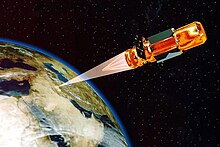Space weapon
This article needs additional citations for verification. (July 2012) |

Space weapons are weapons used in space warfare. They include weapons that can attack space systems in orbit (i.e. anti-satellite weapons), attack targets on the earth from space or disable missiles travelling through space. In the course of the militarisation of space, such weapons were developed mainly by the contesting superpowers during the Cold War, and some remain under development today. Space weapons are also a central theme in military science fiction and sci-fi video games.
Space-to-space weapons
The Soviet
The Soviet uncrewed
Earth-to-space weapons
Strategic Defense Initiative
On March 23, 1983, President Ronald Reagan proposed the Strategic Defense Initiative, a research program with a goal of developing a defensive system which would destroy enemy ICBMs. The defensive system was nicknamed Star Wars, after the movie, by its detractors. Some concepts of the system included
Space-to-Earth weapons
Orbital weaponry

Orbital weaponry is any weapon that is in orbit around a large body such as a planet or moon. As of December 2022, there are no known operative orbital weapons systems, but several nations have deployed orbital surveillance networks to observe other nations or armed forces. Several orbital weaponry systems were designed by the United States and the Soviet Union during the Cold War. During World War II Nazi Germany was also developing plans for an orbital weapon called the Sun gun, an orbital mirror that would have been used to focus and weaponize beams of sunlight.[4]
Development of orbital weaponry was largely halted after the entry into force of the
Orbital bombardment
Orbital bombardment is the act of attacking targets on a planet, moon or other astronomical object from orbit around the object, rather than from an aircraft, or a platform beyond orbit. It has been proposed as a means of attack for several weapons systems concepts, including kinetic bombardment and as a nuclear delivery system.
During the
Orbital bombardment systems with conventional warheads are permitted under the terms of
As of 2020 the only true orbital bombardment in history has been executed for scientific purposes. On 5 April 2019 the Japanese Hayabusa2 robotic space probe released an explosive device called an "impactor" from space onto the surface of asteroid 162173 Ryugu, in order to collect debris released by the explosion. The mission was successful and Hayabusa2 retrieved valuable samples of the celestial body which it brought back to Earth.
In fiction
Fictional or real space weapons in various forms are often prominently featured in science fiction, particularly in military science fiction and in video games with a sci-fi theme.
See also
References
- ^ "Here Is the Soviet Union's Secret Space Cannon". Retrieved 2016-02-22.
- ^ Hollings, Alex (2022-03-11). "The untold history of Russian weapons testing in space". Sandboxx. Retrieved 2022-09-29.
- ^ "Polyus". Encyclopedia Astronautica. Archived from the original on 2010-01-02. Retrieved 2015-02-20.
- Time Magazine. July 9, 1945. Archived from the originalon December 13, 2008.
- .
External links
![]() Media related to Space weapons at Wikimedia Commons
Media related to Space weapons at Wikimedia Commons
- Nuclear Files.org Basic facts and issues regarding space weapons
- SpaceDebate.org – collection of articles, quotes, and links on the debate over space weapons
- GR-1 / SS-X-10 SCRAG (Fractional Orbital Bombardment System)
